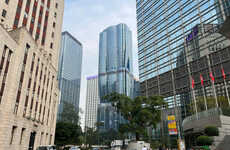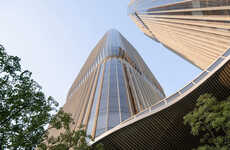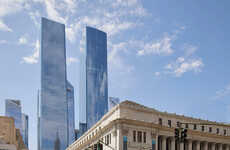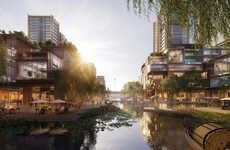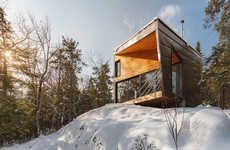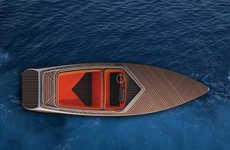
The Ping An Finance Center is the Fourth-Tallest Building in the World
Joey Haar — January 30, 2018 — Art & Design
References: dezeen
The Ping An Financial Center has recently completed construction and opened to the public, making it the fourth-tallest building in the world officially. Located in the Futian business district in Shenzhen, China, the building rises a neck-aching 599 meters, with 100 floors that hold offices for Ping An's 15,500 employees.
Though it's technically an office building, the Ping An Financial Center's sheer size makes it an attraction for tourists as well. The building has an observation deck at the very apex, which the architects expect to draw as many as 9,000 visitors daily (which adds up to 3.2 million visitors annually.)
Not only is the building architecturally interesting thanks to its tapered form and elegant chevrons, but it's also something of an engineering marvel. Though Shenzhen is wet and stormy, which would make any super-tall building a lightning risk, the Ping An Financial Center uses stainless steel piers that deter electricity.
Though it's technically an office building, the Ping An Financial Center's sheer size makes it an attraction for tourists as well. The building has an observation deck at the very apex, which the architects expect to draw as many as 9,000 visitors daily (which adds up to 3.2 million visitors annually.)
Not only is the building architecturally interesting thanks to its tapered form and elegant chevrons, but it's also something of an engineering marvel. Though Shenzhen is wet and stormy, which would make any super-tall building a lightning risk, the Ping An Financial Center uses stainless steel piers that deter electricity.
Trend Themes
1. Super Tall Buildings - Design and construct more structures exceeding 500 meters in height to meet architectural and engineering challenges.
2. Tourism-meets-office - Incorporate observation decks into buildings to increase tourism revenue and brand recognition.
3. Lightning-proof Buildings - Research and develop alternative materials to traditional building materials to create buildings that are resistant to lightning risks.
Industry Implications
1. Architecture and Engineering - Architects and engineers have to design taller buildings that can withstand natural disasters, and innovative materials to minimize electricity risks from lightning strikes.
2. Tourism and Hospitality - Tourism-dependent industries can capitalize on building observation decks to create memorable experiences for visitors, attract more tourism, and generate more revenue.
3. Construction and Building Materials - The companies and researchers within this industry have an opportunity to develop groundbreaking technologies and alternative materials, such as stainless steel piers, that will allow for the construction of more resilient and durable buildings.
3.3
Score
Popularity
Activity
Freshness

